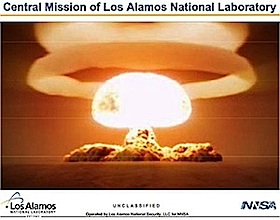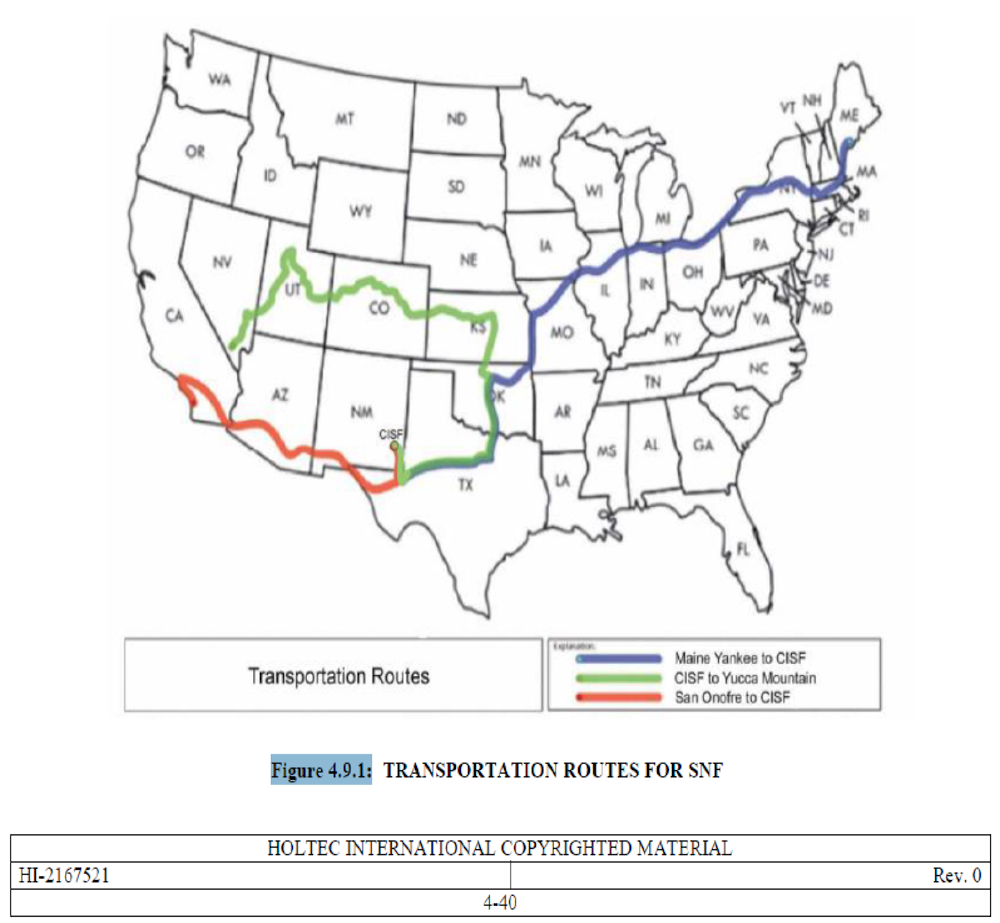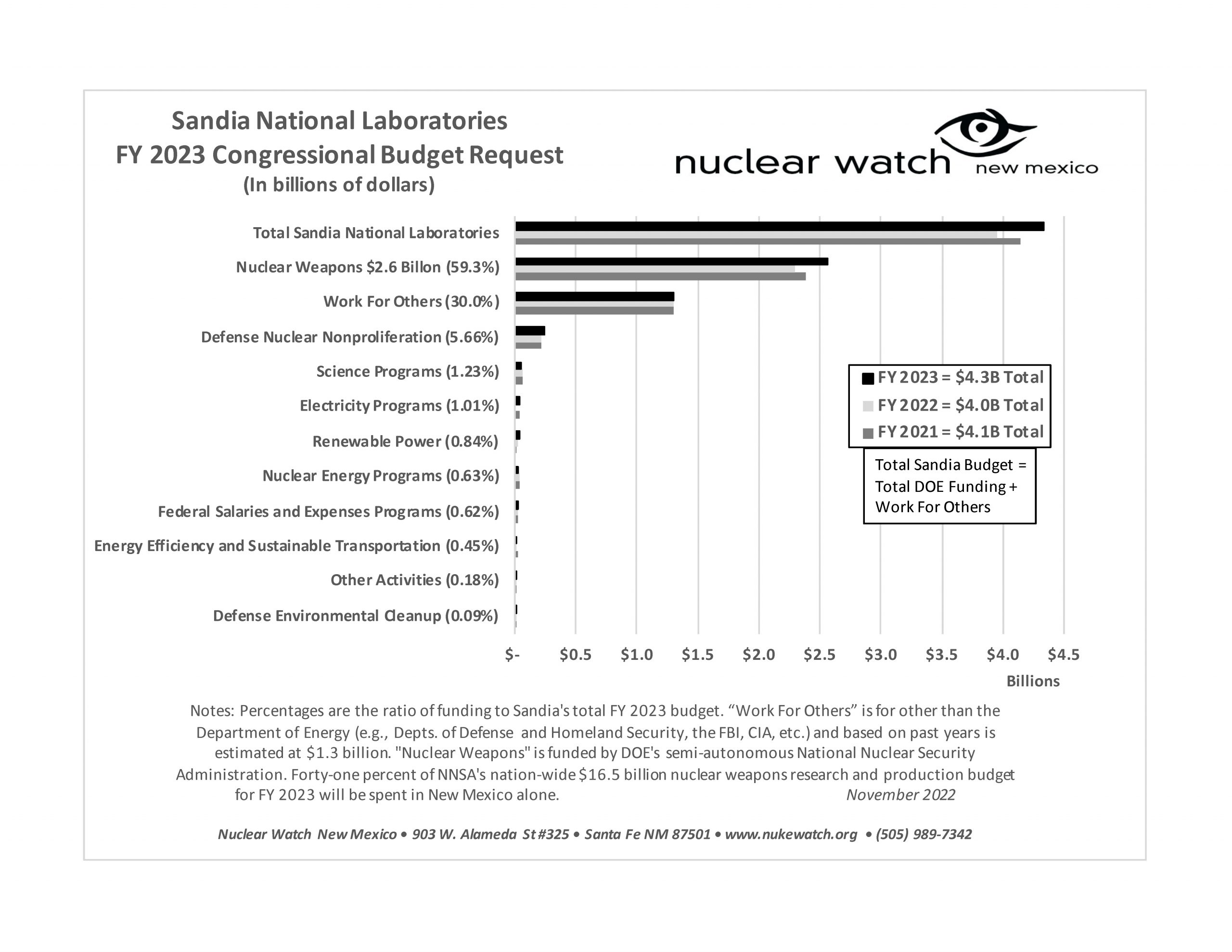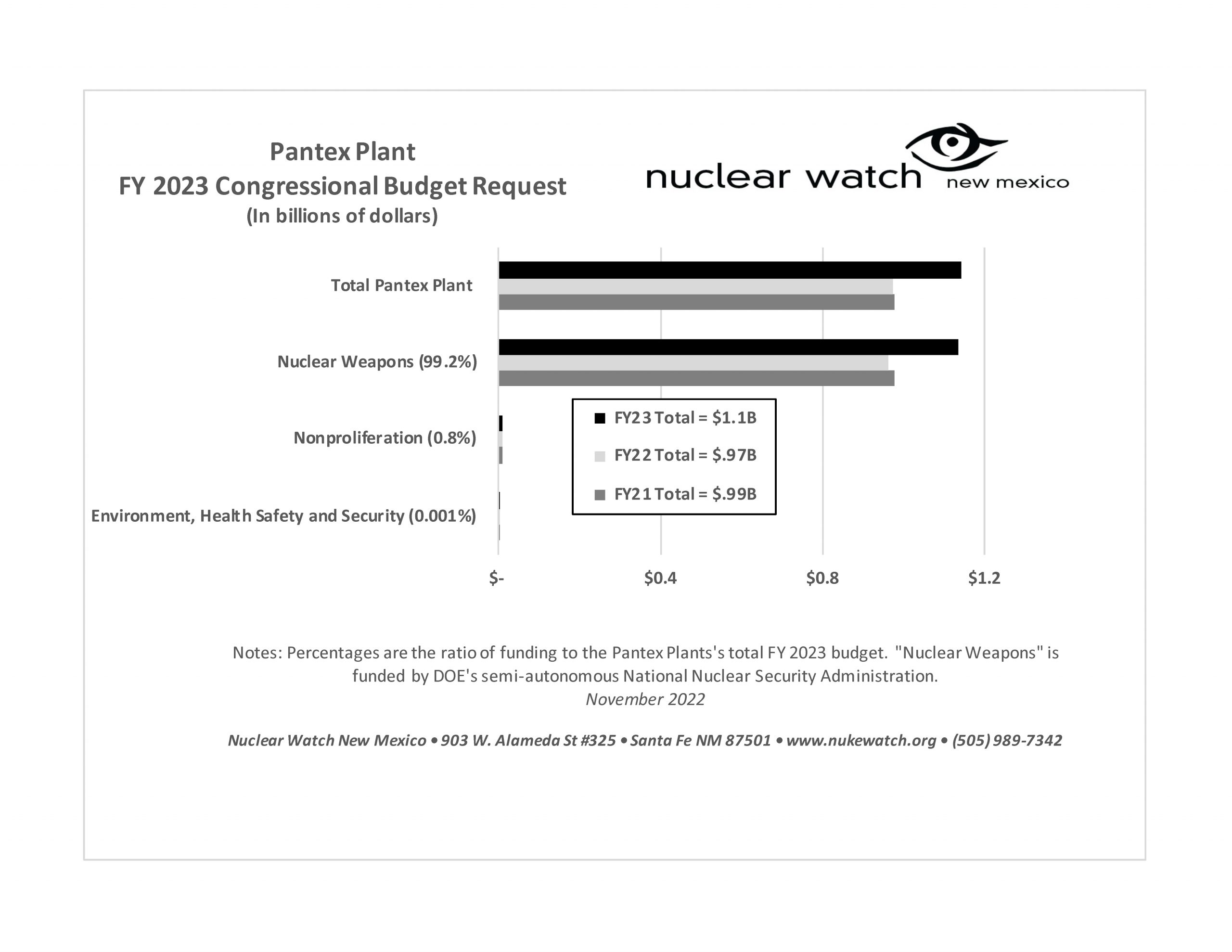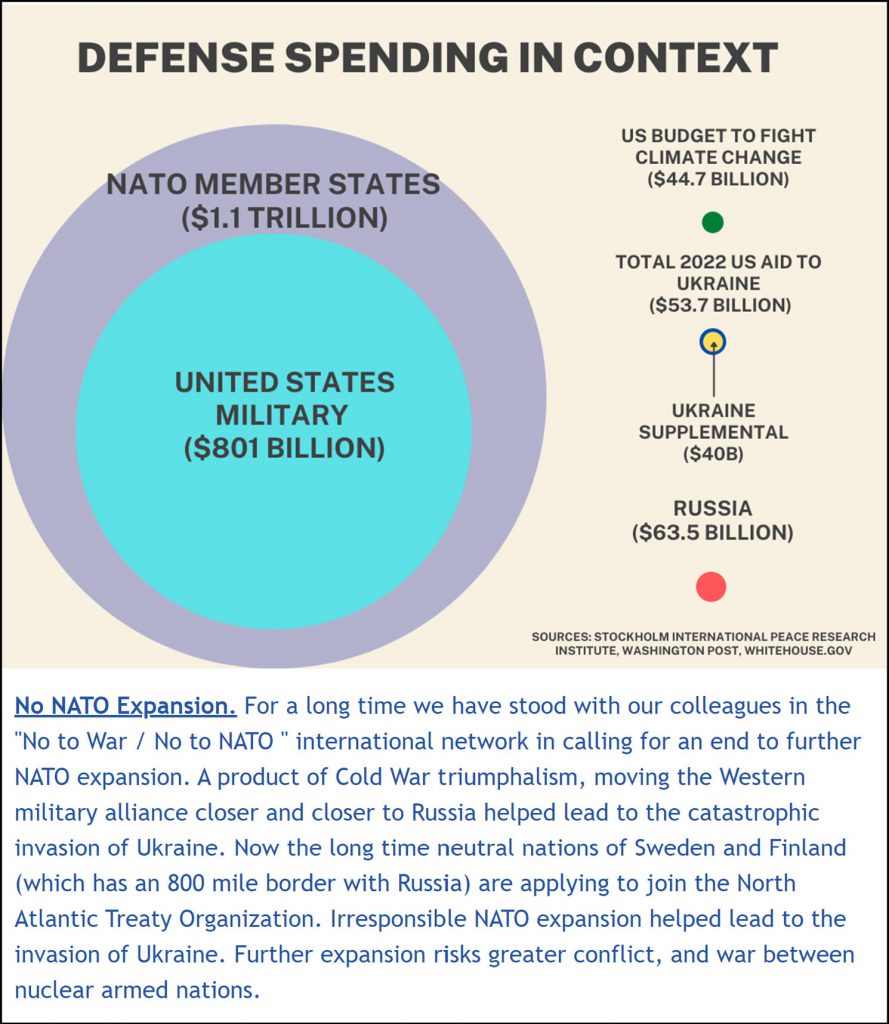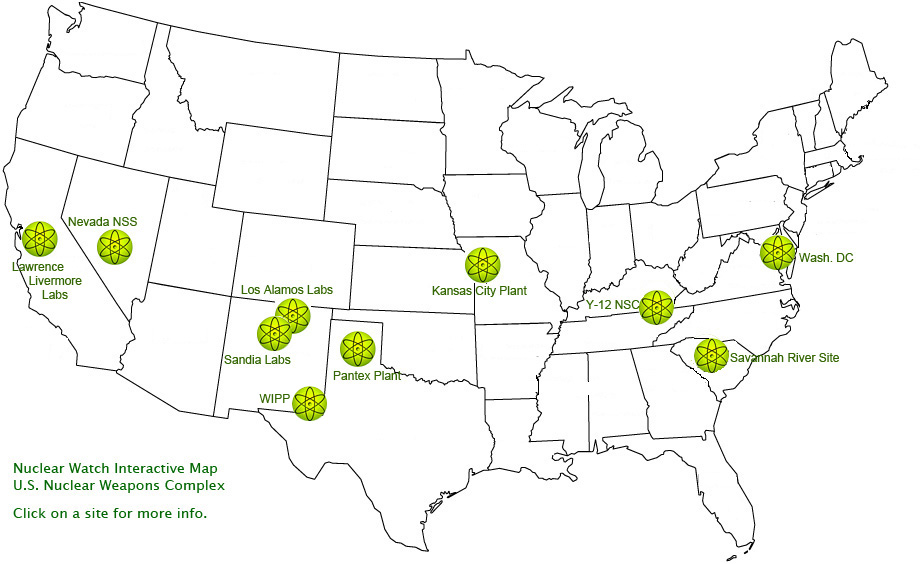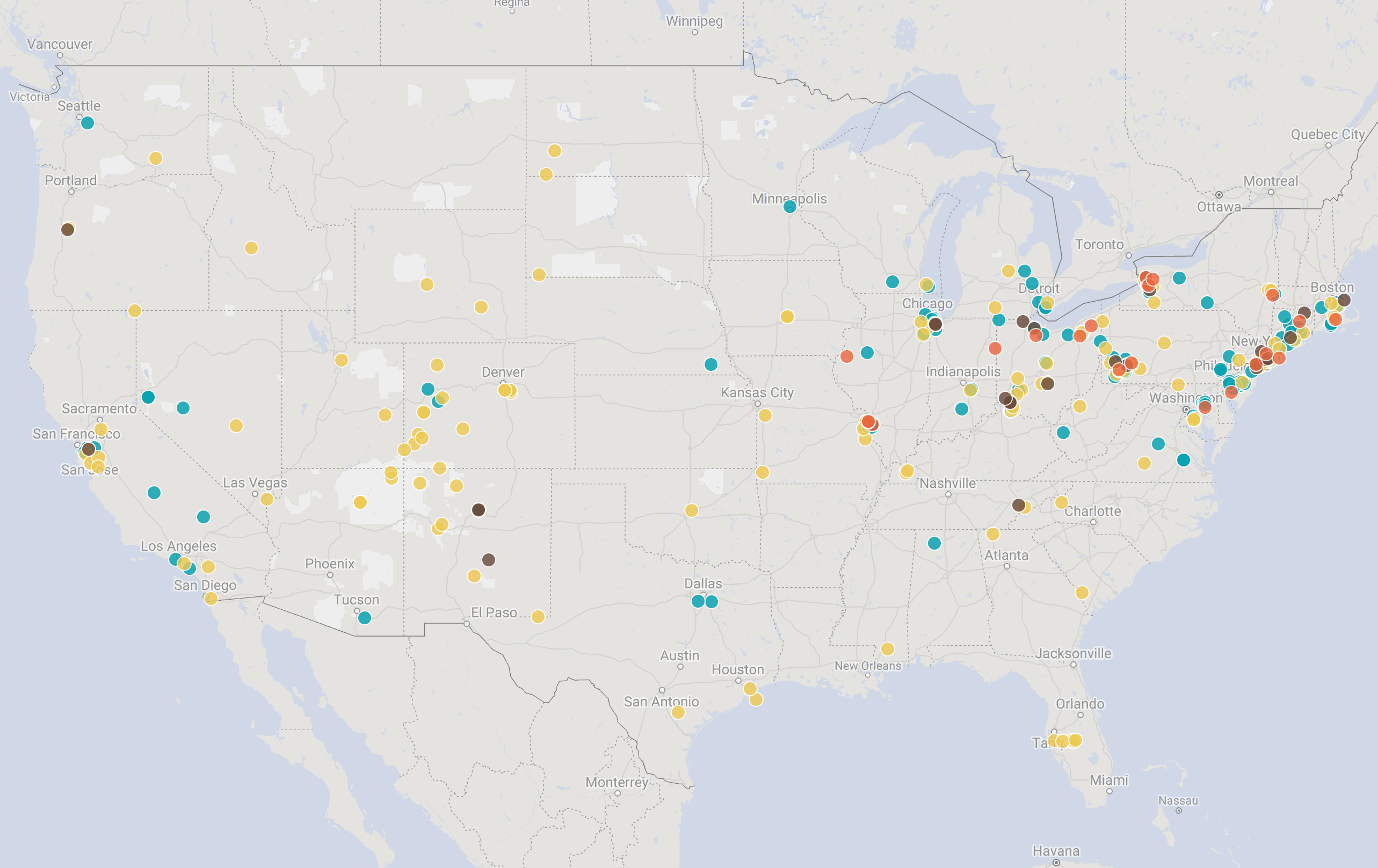QUOTE OF THE WEEK
Nothing Found
It seems we can’t find what you’re looking for. Perhaps searching can help.
LANL’s Central Mission: Los Alamos Lab officials have recently claimed that LANL has moved away from primarily nuclear weapons to “national security”, but what truly remains as the Labs central mission? Here’s the answer from one of its own documents:
LANL’s “Central Mission”- Presented at: RPI Nuclear Data 2011 Symposium for Criticality Safety and Reactor Applications (PDF) 4/27/11
Banner displaying “Nuclear Weapons Are Now Illegal” at the entrance in front of the Los Alamos National Lab to celebrate the Entry Into Force of the Nuclear Weapon Ban Treaty on January 22, 2021
Nothing Found
It seems we can’t find what you’re looking for. Perhaps searching can help.
Follow the Money!
Map of “Nuclear New Mexico”
Nuclear Watch Interactive Map – U.S. Nuclear Weapons Complex
In 1985, US President Ronald Reagan and and Russian President Mikhail Gorbachev declared that “a nuclear war cannot be won and must never be fought.”
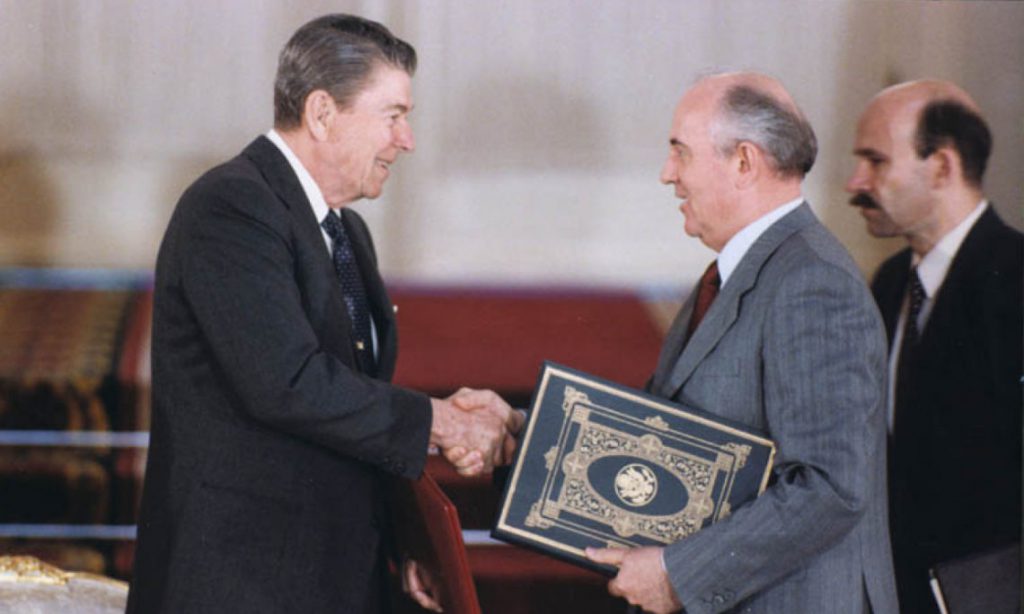
Waste Lands: America’s Forgotten Nuclear Legacy
The Wall St. Journal has compiled a searchable database of contaminated sites across the US. (view)
Related WSJ report: https://www.wsj.com
2022 BLOG POSTS
Nothing Found
It seems we can’t find what you’re looking for. Perhaps searching can help.
New & Updated
GAO Seeks Broader Analysis For Proposed Liquid Waste Facility at LANL
GAO Seeks Broader Analysis For Proposed Liquid Waste Facility at LANL
The Government Accounting Office (GAO) was mandated to review the “analysis of alternatives” (AOA) process applied by NNSA. The process entails identifying, analyzing, and selecting a preferred alternative to best meet the mission need by comparing the operational effectiveness, costs, and risks of potential alternatives. GAO developed a set of practices by reviewing AOA policies and guidance used by seven public and private-sector entities with experience in the AOA process. GAO’s review of DOE’s requirements for AOAs found that they conform to only 1 of the 24 best practices: the practice of defining functional requirements based on mission need.
DOE and NNSA officials acknowledge that unreliable AOAs are a risk factor for major cost increases and schedule delays for NNSA projects. As GAO has previously reported, NNSA has spent billions of dollars designing and partially constructing projects with an estimated cost of $750 million or more, only to later reassess alternatives. NNSA may continue on this path and continue to have limited assurance that it is selecting alternatives that best meet its mission needs and will not result in major cost increases and schedule delays in the future.
Overall, the National Nuclear Security Administration’s (NNSA) analysis of alternatives (AOA) conducted for the Radioactive Liquid Waste Treatment Facility (RLWTF) project only partially met best AOA practices. The mission need for this project—to replace the current, aging facility—was approved in October 2004. NNSA approved an initial AOA for this project in 2006, and after substantial cost increases, conducted a second AOA (analyzed here) in 2013. NNSA currently estimates the project will cost between $168 million and $220 million.
The GAO compared the AOA conducted at the Radioactive Liquid Waste Treatment Facility at LANL with AOA best practices in 24 areas.
For instance in best practices, the team or the decision maker defines selection criteria based on the mission need. What LANL actually did only partially met best practices because the Lab included in the project documentation brief summaries of the selection criteria used but did not describe how these were based on the mission need. LANL included only one of these selection criteria—the scope—in the mission need statement.
In another case, the team or the decision maker is supposed to weigh the selection criteria to reflect the relative importance of each criterion. Here best practices were not met because LANL did not include weighting selection criteria in project documentation.
The ailing facility is still operating.
During 2013, all treated water from the RLWTF was fed to the effluent evaporator. The evaporator was operated 3654 hours on 201 days during 2013, in both one-burner and two-burner mode. A total of 2.64 million liters of treated water were fed to the evaporator, and 2.55 million liters were discharged to the environment as steam from the evaporator stack.
Curies of radioactive materials fed to the effluent evaporator during 2013 were calculated by multiplying the evaporator feed volume (2,638,330 liters) times the flow-weighted average concentration of each radionuclide. Feed to the effluent evaporator in 2013 contained approximately 4.9E-04 curie alpha radioactivity, 3.35E-04 curie beta radioactivity, and 1.7E-02 curie of tritium.
This RLWTF is vital to nuclear weapons production operations at the Lab. But equipment failures could pose a risk to facility workers.
GAO-15-37: Published: Dec 11, 2014. Publicly Released: Dec 11, 2014.
Authors: Del Signore, John C. [Los Alamos National Laboratory]
2014-11-25, LA-UR-14-29097
Comments to DOE Re: Transition of Legacy Clean-up Work at Los Alamos National Laboratory
December 10, 2014
Jack R. Craig, Jr.
DOE EM
Re: Transition of Legacy Clean-up Work at Los Alamos National Laboratory
Mr. Craig,
Please consider these preliminary comments and requests concerning the transition of legacy clean-up work at Los Alamos National Laboratory.
Through comprehensive research, public education and effective citizen action, Nuclear Watch New Mexico seeks to promote safety and environmental protection at regional nuclear facilities; mission diversification away from nuclear weapons programs; greater accountability and cleanup in the nation-wide nuclear weapons complex; and consistent U.S. leadership toward a world free of nuclear weapons.
First, we request that alternatives to the current Department of Energy contract process be considered. The privatization of the nuclear weapons complex may be failing the U.S. taxpayer. Cost overruns plague the current system. Different variations of the same contractors still continue to line up for different variations of the same contracts. Yet, with a few exceptions, cleanup only crawls along. Many of the sites are still contaminated decades after the work was completed. And now, WIPP is shut down.
We ask that alternatives such as looking to governmental agencies instead of private contractors be tasked with cleanup at Los Alamos. For instance, could the Army Corp. of Engineers do the job?
We also strongly request that alternatives to “No-Bid” and “Cost-Plus” contracts be considered first. Recently, Senate Armed Services Committee Chairman John McCain spoke to prohibit the Pentagon from awarding cost-plus contracts, arguing such deals encourage nefariousness. (DefenseNews.com, December 5, 2014)
Second, if a conventional contract is used, we request that the following specific items be included in the proposed new EM contract at LANL. We also ask that these items be included in the ‘bridge’ contract:
- Must be tied to LANL Consent Order and LANL RCRA permit.
- Any “campaigns” must be legally binding, and not used as justification to miss Consent Order milestones.
- Should be more incentive based – less fixed.
- Should be more transparent like ARRA, including public availability of Performance Evaluations.
- Should have dramatically lower overhead costs, for example lower security and no LDRD costs. These overhead costs should be made public just as the old Functional Support Costs were available to the public.
- Must include public update meetings semi-annually.
- Should favor local/regional economic development.
- Must have public update meetings at least semi-annually.
Third, for the new bridge contract and any final contract we ask:
- Cleanup must continue at current pace during transition.
- There must be a new lifecycle baseline – with the range with assumptions spelled out. Comprehensive cleanup must be considered, not just cap and cover.
- Corrective Measures Evaluations must be completed on all areas as one of the priorities.
Finally, concerning the new bridge contract, the synopsis doesn’t address the issue of how much LANS will be paid under the to-be-finalized bridge contract in relation to how much it would have been paid under the existing contract. It also doesn’t state which of the tasks mentioned are different than under the existing contract. We request that costs and tasks be fully described in the to-be-finalized bridge contract.
Thank you for your consideration in these matters and please call if you have any questions.
Sincerely,
Jay Coghlan Scott Kovac
Executive Director Research Director
Safety Analysis Flaws Plague Los Alamos TRU Waste Handing Facility
Safety Analysis Flaws Plague Los Alamos TRU Waste Handing Facility
The Defense Nuclear Facilities Safety Board (DNFSB) believes that the Radioassay and Nondestructive Testing (RANT) Shipping Facility at Los Alamos National Laboratory must resolve safety issues prior to resuming operations. The DNFSB staff review team identified “significant flaws” in hazard and accident analyses.
The RANT Shipping Facility is used to load transuranic (TRU) waste, typically either waste drums or standard waste boxes, into TRUPACT shipping containers. This facility supports the LANL TRU program and will be used long-term. The RANT Shipping Facility is currently in standby with no TRU waste present, pending the resumption of TRU waste shipments.
In November 2013, the contractor, LANS, submitted a new safety analysis, called a Documented Safety Analysis (DSA), to DOE oversight officials at the Los Alamos Field Office (LAFO) for approval. In February 2014, WIPP was shut down due to a radiation leak in the underground. It is believed that wheat-based kitty litter was mixed with nitrate salts in a transuranic waste drum as it was processed at Los Alamos that potentially caused the reaction that breached the container. In July 2014, LAFO completed its review of the RANT DSA and noted only four actions needed.
The DNFSB staff reviewed the DSA and identified significant weaknesses in the hazard analysis (HA), accident analysis, and safety controls. The review revealed inadequate identification and implementation of safety controls to protect the public and workers.
The DNFSB report found that LANS and LAFO underestimated consequences from potential crane failure accidents, seismic events, and fires. Underestimating possible consequences like these can lead to increased radiologic releases to the environment.
Defense Nuclear Facilities Safety Board Staff Issue Report September 29, 2014
Below is a Google Earth image of the RANT facility. Notice the 8 TRUPACT trailers with three round TRUPACT containers each on them.
NNSA Governance Advisory Panel Condones Diminishing Federal Oversight Of Failing Contractors
Santa Fe, NM – Yesterday, the Congressional Advisory Panel on the Governance of the Nuclear Security Enterprise released its long awaited report, entitled “A New Foundation for the Nuclear Enterprise.” According to enabling language in the FY 2013 Defense Authorization Act, “The purpose of the advisory panel is to examine options and make recommendations for revising the governance structure, mission, and management of the nuclear security enterprise.” This means the nuclear weapons complex owned by the Department of Energy’s semi-autonomous National Nuclear Security Administration (NNSA) and run by its contractors. In an attempt to give increased prominence to nuclear weapons programs, the Panel goes so far as to recommend that the Department of Energy be renamed the Department of Energy and Nuclear Security.
The Panel itself is full of conflicts-of-interest. It is co-chaired by Norman Augustine, the former CEO of Lockheed Martin, which is the sole manager of the Sandia Labs and runs the Y-12 and Pantex nuclear weapons production plants in partnership with the Bechtel Corp. The other co-chair, Admiral Robert Mies, sits on the Board of Governors of both for-profit contractors that run the Los Alamos and Lawrence Livermore Labs, as do former congresswoman Ellen Tauscher and Michael Anastasio, former director of both labs. Yet another panel member, Franklin C. Miller, sits on the Sandia Corporation Board of Directors.
But the most questionable panel member is former Congresswoman Heather Wilson (ex.-R-NM). While still in office she signed a contract for “consulting” services with the Sandia National Laboratories that had no written work requirements. The day after she stepped down from office she started being paid $10,000 a month, and went on to secure a similar contract from the Los Alamos Lab for the same amount of money. The DOE Inspector General has recently found that the Sandia contractor (wholly owned by Lockheed Martin) had engaged in highly improper, if not illegal, lobbying of Congress for contract extensions, in which Heather Wilson was “deeply, deeply involved.” Both Sandia and LANL were forced to return to the government the $450,000 they had paid to Wilson, but she has not returned any money.
The Panel’s report laments the dysfunctional relationship between NNSA and its contractors, and deplores the loss of mutual trust. But while profits are rising, contractors are being held to fewer and fewer performance benchmarks, which the Panel does little if anything to fix. Performance benchmarks were previously codified in annual Performance Evaluation Plans (PEPs), but have been subsequently stripped. As a case in point, the FY 2012 Performance Evaluation Plan for the Los Alamos Lab contractor was 89 pages long, full of concrete performance benchmarks. The restructured FY 2013 Plan was nine pages long, with vague performance benchmarks.
This diminishing federal oversight flies in the face of a long history of project delays and immense cost increases for which contractors are responsible, but not held accountable. For example, the former contractor for the Y-12 nuclear weapons plant committed a half-billion dollar design mistake for the Uranium Processing Facility, but has not been publicly disciplined. Y-12’s new contractor just awarded Bechtel a no-bid UPF construction contract, which in effect awards itself since the contractor is principally composed of Lockheed Martin and Bechtel. This is despite the fact that under Bechtel management the Chemistry and Metallurgy Research Replacement Project at Los Alamos exploded in costs from ~$600 million to ~$.6.5 billion, and the Waste Treatment Plant at Hanford from ~$3.5 billion to ~$13.5 billion.
Contractors have also committed very serious operational mistakes. The LANL contractor used unapproved waste handling methods to prepare plutonium-contaminated radioactive wastes for disposal at the Waste Isolation Pilot Plant (WIPP). A waste drum subsequently ruptured, contaminating 21 workers and closing WIPP, causing estimated reopening costs of a half-billion dollars (which will no doubt increase) and $54 million in New Mexico state fines.
As another example, the former Y-12 contractor self-appraised its security management program as “excellent” and its physical security as “good,” which the National Nuclear Security Administration (NNSA) approved while awarding management fees. Both were shaken to their cores when an 82-year old nun and two elderly colleagues cut through three security fences to protest nuclear weapons in a very sensitive area previously thought impregnable.
Despite all this, the Panel makes no specific recommendations to put performance benchmarks back into management contracts. Instead, it proposes that the number of budget line items be reduced, which could further erode transparency, accountability, and congressional oversight, and increase the ability of NNSA and its contractors to move money around.
Perhaps most alarmingly, the Panel recommends that congressional oversight be strengthened by having the DOE Secretary report to the Senate Energy and Natural Resources and Armed Services Committees, and to the House Energy and Commerce and Armed Services Committees. This would likely have the opposite effect, as it seems to preclude the traditional jurisdiction of the House and Senate Energy and Water Development Appropriations Subcommittees, which have provided key oversight in the past, and have often cut certain nuclear weapons programs. Indeed, later in the report, the Panel suggests (short of a formal recommendation) that funding authority for NNSA nuclear weapons programs be invested in the Defense Subcommittees of the House and Senate Appropriations Committees. Again, this appears to exclude Energy and Water Appropriations, which could have profound implications by weakening congressional fiscal constraints on the nuclear weapons complex.
Jay Coghlan, Nuclear Watch Director, commented, “The Panel’s self-interested premise that the Nuclear Security Enterprise needs a new foundation is wrong. First, call it what it is, not some kind of innocuous sounding “enterprise,” but rather a massive research and production complex that is pushing an unaffordable trillion dollar modernization program for nuclear warheads, missiles, subs and bombers. This will divert taxpayers’ dollars from meeting the real national security threats of nuclear weapons proliferation and climate change. The Panel failed by not arguing for prudent maintenance of the stockpile, instead supporting a perpetual work program of risky life extension programs for existing nuclear weapons that will enrich contractors.”
# # #
“A New Foundation for the Nuclear Enterprise” by the Congressional Advisory Panel on the Governance of the Nuclear Security Enterprise is available at
http://cdn.knoxblogs.com/atomiccity/wp-content/uploads/sites/11/2014/12/Governance.pdf?_ga=1.136311025.1198700939.1418359009
The DOE Inspector General “Special Inquiry: Alleged Attempts by Sandia National Laboratories to Influence Congress and Federal Officials on a Contract Extension” is available at
http://www.energy.gov/sites/prod/files/2014/11/f19/IG-0927.pdf
The DOE’s Inspector General’s quote of Heather Wilson’s deep involvement in improper lobbying on behalf of the Sandia Labs is from
http://rapidcityjournal.com/news/local/mines-president-named-in-doe-inspector-general-s-probe/article_b984ab84-d593-5578-8007-e70e7c9e986f.html
NukeWatch Urges Increasing DOE Accountability in Wake of Fines
On December 6, the New Mexico Environment Department (NMED) declared multiple violations at both the Waste Isolation Pilot Plant (WIPP) and Los Alamos National Laboratory (LANL). NMED plans to fine WIPP $17.7 million and LANL $36.6 million due to major procedural problems related to the handling of radioactive transuranic (TRU) wastes that contributed to two significant incidents at WIPP earlier this year.
In addition to “failure to adequately characterize waste” and other violations, LANL was cited for the processing of nitrate-bearing wastes and adding neutralizing agents to that waste stream. LANL treated this procedure as if it was outside the state hazardous waste permit, but NMED determined that these operations were not exempt. LANL treated 100s of waste drums without a permit, and one of these was apparently the cause of the February 14, 2014 radioactive release at WIPP that contaminated 21 workers.
WIPP was cited for, among other violations, not notifying NMED in a timely fashion of the February 14 radioactive release.
The $36.6 million fine at LANL is based on up to $10,000 per day per non-compliance, but still represents less than 2% of the Lab’s $2.1 billion annual budget. The contractor that runs the Lab, Los Alamos National Security, LLC, is eligible to earn $57 million in bonus award fees for the fiscal year that ended last September 30th. The fines should be taken out of the bonuses.
NMED stipulated that the penalties couldn’t be paid for out of designated funding for environmental cleanup or operational needs at LANL and WIPP.
Nuclear Watch New Mexico applauds these efforts to hold the Department of Energy accountable in New Mexico and we urge NMED to not negotiate these relatively modest fines down, as is typically the case. These fines should be paid out of the contractor’s profits. The Lab had this waste for over 20 years and still could not get it right. We hope these NMED fines are a wake up call for safe, comprehensive cleanup of all the wastes left from the Cold War at the Los Alamos Lab.”
Watchdog Urges Increasing DOE Accountability in Wake of Fines
Santa Fe, NM
Today the New Mexico Environment Department (NMED) declared multiple violations at both the Waste Isolation Pilot Plant (WIPP) and Los Alamos National Laboratory (LANL). NMED plans to fine WIPP $17.7 million and LANL $36.6 million due to major procedural problems related to the handling of radioactive transuranic (TRU) wastes that contributed to two significant incidents at WIPP earlier this year.
In addition to “failure to adequately characterize waste” and other violations, LANL was cited for the processing of nitrate-bearing wastes and adding neutralizing agents to that waste stream. LANL treated this procedure as if it was outside the state hazardous waste permit, but NMED determined that these operations were not exempt. LANL treated 100s of waste drums without a permit, and one of these was apparently the cause of the February 14, 2014, radioactive release at WIPP that contaminated 21 workers.
FY 2015 Defense Authorization Act cuts Safety Board employees
The House Armed Services Committee has tried repeatedly to cripple the Defense Nuclear Facilities Safety Board, realizing that the Board slows down what the nuclear weaponeers want to do (and causes the estimated costs of new nuclear facilities to explode because of safety concerns).
The Board’s enabling legislation authorized a staff of up to 150 personnel. HASC tried to cut it down to 120. The final House-Senate agreement on the FY 2015 Defense Authorization Act cuts it to 130. Remember, the Board covers the entire active nuclear weapons complex and then some, and is often the only adult in the room when it comes to nuclear safety issues. For example, the Los Alamos Lab’s plutonium pit production facility has not conducted major operations since the end of June 2013 because of nuclear criticality safety issues that the Board raised.
The relevant FY 2015 Defense Authorization Act Agreement language is as follows, page 350, https://web.archive.org/web/20210718064321/https://www.armed-services.senate.gov/download/fy2015-ndaa-conference-jes
Number of employees of Defense Nuclear Facilities Safety Board(sec. 3203)
The House bill contained a provision (sec. 3203) that would amend section 313(b)(1)(A) of the Atomic Energy Act of 1954 (42 U.S.C. 2286b(b)(1)(A)) to limit the number of full-time employees of the Defense Nuclear Facilities Safety Board to 120. The Senate committee-reported bill contained no similar provision. The agreement includes the House provision with an amendment that would limit the number of employees to 130. – end of quote –
The Board deserves our ongoing support. In Nuclear Watch NM’s view, the Board should be expanded, not cut, especially in light of the govermnent’s plans to spend more than a trillion dollars over the next 30 years on nuclear weapons modernization.
–
Watchdogs Urge Reduced Contractor Fees at the Los Alamos Lab
Watchdogs Urge Reduced Contractor Fees at the Los Alamos Lab
Washington, DC and Santa Fe, NM – Today, the Project On Government Oversight and Nuclear Watch New Mexico sent the Secretary of the Department of Energy a letter urging that the contractor award fee for the Los Alamos National Laboratory (LANL) be slashed. The total possible fee that can be earned for FY 2014, which ended September 30, is $17.1 million in fixed fee and up to $40 million in incentive fee. The watchdog organizations argue that the incentive fee award should be cut at least in half because of grossly substandard contractor performance.
The Los Alamos Lab is run by Los Alamos National Security, LLC (LANS), whose two main partners are the University of California (UC) and the privately held Bechtel Corporation. UC ran the Lab as a nonprofit until June 2006, and received approximately $8 million in annual compensation. In contrast, the for-profit LANS was awarded $51.9 million in FY 2013, or more than six times the old nonprofit fee, for no apparent improvement in contract management. As recently reported by The Albuquerque Journal, LANL Director Charlie McMillan makes $1.5 million annually while also acting as president of LANS, which is a possible conflict of interest.
LANS’ contract performance in FY 2014 was demonstrably worse than other years. The best, well-publicized evidence is that the Lab used unapproved waste handling methods to prepare plutonium-contaminated radioactive wastes for disposal at the Waste Isolation Pilot Plant (WIPP). A waste drum subsequently ruptured, contaminating 21 workers and closing WIPP, with estimated reopening costs of a half-billion dollars (which will no doubt increase). Moreover, the New Mexico Environment Department now threatens to levy substantial fines against LANL because of its missed deadline to send transuranic wastes to WIPP.
Less well known, the Lab is the nation’s only so-called “Plutonium Center of Excellence,” but has been unable to conduct major operations at its plutonium facility since the end of June 2013 because of nuclear criticality safety issues. The two watchdog organizations do not support plutonium operations at LANL, much of which is geared towards the unnecessary production of plutonium pits, the fissile cores of nuclear weapons. However, at the same time, contractors should not be paid for work they don’t do.
Peter Stockton, POGO’s senior investigator, commented, “It’s time for some tough love! LANS screws up the WIPP facility, costing the government at least $500 million, and had to stop operations at its plutonium facility for over a year because of nuclear safety concerns. In the face of these debacles, DOE should be seeking restitution, not providing a performance bonus.”
Bechtel has had a particularly troubling contracting history with DOE. Under its management estimated costs for the Waste Treatment Plant at the Hanford nuclear reservation soared from $3.5 billion to $13 billion, with numerous whistleblower complaints. Similarly, under LANS’ management of the Los Alamos Lab, estimated costs for the Chemistry and Metallurgy Research Replacement Project mushroomed from around $600 million to $6.5 billion, leading to cancellation of the proposed “Nuclear Facility.” Now, in effect, Bechtel has awarded itself the construction contract to build the Uranium Processing Facility at the Y-12 production plant in Oak Ridge, TN. Under a previous contractor estimated costs for the UPF exploded from around $600 million to as high as $19 billion. To help fix that, the UPF’s mission has been recently narrowed to nuclear weapons components production only (eliminating dismantlements) in order to hold to a budget cap of $6.5 billion. That means the American taxpayer is paying more for less, and arguably for the wrong priorities. Lockheed Martin and Bechtel run the new Y-12 management contract.
Jay Coghlan, Nuclear Watch Director, commented, “The Department of Energy’s cozy relationships with its contractors must end, given their repeated failures and massive cost overruns. Substandard performance by the Los Alamos Lab contractor is costing the taxpayer dearly, and therefore DOE should slash its incentive performance fee award at least in half. From there, DOE should consider booting Los Alamos National Security, LLC for another contractor entirely.”
# # #
The POGO/Nuclear Watch NM letter to DOE Secretary Ernest Moniz urging reduced award fees for the Los Alamos Lab contractor is available at
https://nukewatch.org/importantdocs/resources/POGO-NukeWatch-Moniz-LANS-performance-12-3-14.pdf
Highlights of National Nuclear Security Administration Issues in the House FY 2015 National Defense Authorization Act
Highlights of National Nuclear Security Administration Issues
In the House FY 2015 National Defense Authorization Act
Sources: House FY 2015 NDAA, pages 1516 – 1555 and budget tables beginning page 1643.
http://docs.house.gov/billsthisweek/20141201/CPRT-113-HPRT-RU00-S1847.pdf
Compiled by Jay Coghlan, Nuclear Watch New Mexico. Any comments by me are italicized.
The House FY 2015 National Defense Authorization Act authorizes $8.2 billion for the National Nuclear Security Administration’s (NNSA’s) nuclear weapons programs, in contrast to the Obama Administration’s request of $8.3 billion.
It meets the Administration’s $643 million request for the B61 Life Extension Program, and raises the $9.4 million request for the Long-Range Stand-Off (AKA air-launched cruise missile) nuclear warhead to $17 million.
It raises the $30 million request for dismantlements to $40 million.
It meets the $335 million request for the Uranium Capabilities Replacement Project (AKA the Uranium Processing Facility).
It raises the $196 million request for construction of the MOX Fuel Fabrication Facility to $341 million.
It cuts the $410.8 million request for the NNSA Office of the Administrator to $386.9 million.
SEC. 3111. DESIGN AND USE OF PROTOTYPES OF NUCLEAR WEAPONS FOR INTELLIGENCE PURPOSES requires the lab directors to “develop a multiyear plan to design and build prototypes of nuclear weapons to further intelligence estimates with respect to foreign nuclear weapons activities and capabilities.” This effort “emphasizes the competencies of the national security laboratories with respect to designing and building prototypes of nuclear weapons.”
This could possibly be abused by U.S. designers to design new nuclear weapons under the rubric of gathering foreign intelligence.
SEC. 3112. PLUTONIUM PIT PRODUCTION CAPACITY declares that the “production of plutonium pits and other nuclear weapons components must be driven by the requirement to hedge against technical and geopolitical risk and not solely by the needs of life extension programs.” It goes on to require the actual production of not less than 10 plutonium war reserve pits during 2024, 20 during 2025, 30 during 2026, and demonstration of the capability to produce 80 pits per year by 2027.
How convenient to delink plutonium pit production from the actual needs of Life Extension Programs, since the only LEP that required new pit production has been indefinitely delayed. This was for the so-called Interoperable Warhead, which faced exorbitant costs and lack of support by the Navy. Nevertheless, the House Armed Services Committee now mandates expensive and provocative expanded plutonium pit production for which there is no clear need. Ironically, the Los Alamos National Laboratory has been unable to conduct plutonium operations at its pit production facility since June 2013 because of nuclear criticality safety issues.
SEC. 3118. COST CONTAINMENT FOR URANIUM CAPABILITIES REPLACEMENT PROJECT limits Phase 1 of construction of the Uranium Processing Facility to $4.2 billion. That cap could be adjusted if the DOE Secretary submits a detailed justification, including “a detailed description of the actions taken to hold appropriate contractors, employees of contractors, and employees of the Federal Government accountable for the repeated failures within the project.” It also requires that uranium operations in Building 9212 cease by 2025.
Notably, the House NDAA does NOT contain a definitional change that NNSA shopped to key congressional committees that would have narrowed the Uranium Processing Facility’s mission, thereby helping to contain its costs (which was previously capped at $6.5 billion). Thus the Uranium Processing Facility could soon be headed for another budget crisis.
SEC. 3119. PRODUCTION OF NUCLEAR WARHEAD FOR LONG-RANGE STANDOFF WEAPON requires that “The Secretary of Energy shall deliver a first production unit for a nuclear warhead for the long-range standoff weapon by not later than September 30, 2025.”
This is meant to block the Administration’s proposed two year delay. Rushing into the LRSO nuclear warhead makes no sense because it puts the cart before the horse when work on the new air-launched cruise missile has yet to start.
SEC. 3120. DISPOSITION OF WEAPONS-USABLE PLUTONIUM requires another report on possible alternatives to the MOX Program for plutonium disposition, including their life cycle costs.
Nevertheless, as previously stated, the Act increases funding for construction of the MOX Fuel Fabrication Facility to $341 million.
SEC. 3132. ANALYSIS OF EXISTING FACILITIES AND SENSE OF CONGRESS WITH RESPECT TO PLUTONIUM STRATEGY requires “analysis of using or modifying existing facilities of the nuclear security enterprise… to support [NNSA’s plutonium] strategy, as part of critical decision 1 in the acquisition process for the design and construction of modular structures associated with operations of the PF–4 facility at Los Alamos National Laboratory, Los Alamos, New Mexico.” This is to include “plans to construct two modular structures that will achieve full operating capability not later than 2027,” all for the purpose of “meet[ing] the requirements for implementation of a responsive infrastructure, including meeting plutonium pit production requirements.”
But there are no actual pit production requirements. Recall that the Act delinks plutonium pit production from the actual needs of the nuclear weapons stockpile to become a hedge against undefined and indefinite “technical and geopolitical risk.” The Act also requires major expansion of production at LANL, when significant budget, environmental and safety issues for existing plutonium pit production remain unresolved (witness the use of unauthorized waste treatment processes by the Lab that led to the contamination of 21 workers and the closure of the Waste Isolation Pilot Plant, with initial estimates of $.5 billion dollars to reopen). The House Armed Services Committee’s mandate of expanded plutonium pit production is an ideological statement of nuclear weapons forever, rather than being driven by the technical needs of the stockpile. This is an unnecessary and provocative waste of taxpayer’s money that if enacted is doomed for failure.
NNSA Considers Stuffing More Plutonium Into New Facility
Despite the fact that no one has come up with a good reason to increase plutonium pit production for the nation’s nuclear weapons stockpile, officials want to study the possibility of radically increasing the amount of plutonium allowed in a recently completed laboratory at the Los Alamos National Laboratory.
The Deputy Administrator for National Nuclear Security Administration (NNSA) Defense Programs, Don Cook, has requested an analysis to increase the radioactive materials inventory in the recently completed Radiological Laboratory Utility Office Building (RLUOB) to up to 400 grams of plutonium-239, the isotope used in nuclear weapons. The RLUOB, which originally was limited to 8.4 grams of Pu 239, was built as Phase 1 of the Chemistry and Metallurgy Research Replacement Project at LANL that would have expanded plutonium pit production to 50 – 80 pits per year (pits are the radioactive cores of nuclear weapons). LANL’s current capacity is 20 pits per year. Phase 2 of the CMRR project, the “Nuclear Facility,” was canceled because of lack of clear need and a bulging ten-fold increase in costs.
This RLUOB, along with some floor space in the existing Plutonium Facility (PF-4), will replace the old Chemistry and Metallurgy Research Building, which is slated for closure in 2019. The Laboratory was working on a plutonium strategy to move out of CMR and maintain the current plutonium capability.
But NNSA recently increased the maximum amount of radiological materials allowed in the RLOUB, and all “radiological” facilities, from 8.4 grams to 38.6 grams. Internal Lab documents floated plans that could have increased the limit again by two or three times by treating each little laboratory in the RLUOB as its own radiological facility. This could have increased the limit to 115.8 grams of Pu239.
But NNSA apparently wants to go big. The new analysis is to consider the RLUOB as a Hazard Category 3 nuclear facility, which is a huge step up from its current designation as a radiological facility.
Scott Kovac, Research and Operations Director for Nuclear Watch New Mexico, said, “This turkey of a plan is stuffed with bad ideas – The RLUOB is not seismically qualified for that amount of plutonium. A new supplemental environmental impact statement will be needed. There is no need for more plutonium pits, except for new nuclear weapons, because they last for around 100 years and nuclear weapons stockpiles are decreasing. And apparently LANL can’t safely handle plutonium anyway, as major operations with plutonium have been paused since June 2013 because of nuclear criticality safety issues. Finally, it was LANL’s improper handling of plutonium waste that contaminated 21 workers at the Waste Isolation Pilot Plant, causing it to close with at least a half billion dollars in costs to reopen. We say no to more plutonium at Los Alamos!”
# # #
Read the Defense Nuclear Facilities Safety Board report here.
NNSA Considers Stuffing More Plutonium Into New Facility
Despite the fact that no one has come up with a good reason to increase plutonium pit production for the nation’s nuclear weapons stockpile, officials want to study the possibility of radically increasing the amount of plutonium allowed in a recently completed laboratory at the Los Alamos National Laboratory.
The Deputy Administrator for National Nuclear Security Administration (NNSA) Defense Programs, Don Cook, has requested an analysis to increase the radioactive materials inventory in the recently completed Radiological Laboratory Utility Office Building (RLUOB) to up to 400 grams of plutonium-239, the isotope used in nuclear weapons. The RLUOB, which originally was limited to 8.4 grams of Pu 239, was built as Phase 1 of the Chemistry and Metallurgy Research Replacement Project at LANL that would have expanded plutonium pit production to 50 – 80 pits per year (pits are the radioactive cores of nuclear weapons). LANL’s current capacity is 20 pits per year. Phase 2 of the CMRR project, the “Nuclear Facility,” was canceled because of lack of clear need and a bulging ten-fold increase in costs.
Senator Markey Nov. 17, 2014 letter to Secretary Moniz regarding the case of James Doyle
View/Download Full PDF HERE
“Increasing the Effectiveness of Nonproliferation and Verification Technology: Development Programs, Initial Findings and Recommendations”
by Dr. James Doyle, Assisted by Jay Coghlan and Scott Kovac (NukeWatch) Nov 16, 2014
View/Download Full PDF HERE
Comment on NYT article “Which President Cut the Most Nukes?”
Today’s New York Times article “Which President Cut the Most Nukes?” does a public service by pointing out that contrary to his rhetoric, Obama has the lowest nuclear weapons dismantlement rate of any president. In fact, he proposes to cut funding for dismantlements by 45% in FY 2015, along with cutting nonproliferation programs designed to keep nuclear materials safe from terrorists by 20%. This is to help pay for increasing nuclear weapons production.
The U.S. government under Obama is completely rebuilding the nuclear weapons production complex. This includes multi-billion dollar facilities for plutonium components at Los Alamos, NM, and highly enriched uranium at Oak Ridge, TN, both of which have massive cost overruns. It also includes a new Kansas City Plant, built by private investors in a sweetheart deal, for the thousand of nonnuclear components (fuzes, radars, etc.) needed to make nuclear weapons deliverable.
In all, “modernization” of nuclear weapons and their delivery systems is expected to cost more than a trillion dollars over the next 30 years. This will inevitably rob American taxpayers of what they truly need (upgraded public infrastructure, environmental and health protection, public education, etc.), while enriching the usual, unaccountable defense contractors. All of these new production plants are expected to manufacture nuclear weapons until 2075, a far cry from the aspirational future world free of nuclear weapons that President Obama claims to profess.
See “Which President Cut the Most Nukes?” at http://www.nytimes.com/2014/11/02/sunday-review/which-president-cut-the-most-nukes.html?emc=edit_tnt_20141101&nlid=59407362&tntemail0=y&_r=0
ACTION ALERTS
Nothing Found
It seems we can’t find what you’re looking for. Perhaps searching can help.
Nothing Found
It seems we can’t find what you’re looking for. Perhaps searching can help.
Interfaith Panel Discussion on Nuclear Disarmament - August 9
Nothing Found
It seems we can’t find what you’re looking for. Perhaps searching can help.
New Nuclear Media
Nothing Found
It seems we can’t find what you’re looking for. Perhaps searching can help.

